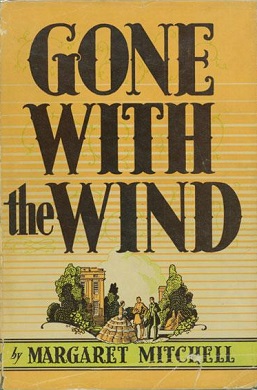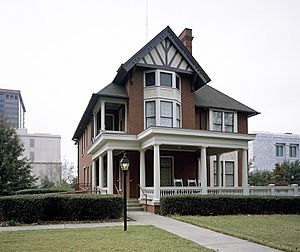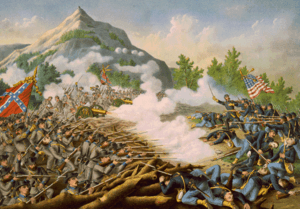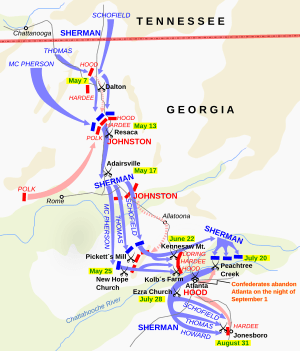Gone with the Wind facts for kids

First-edition cover
|
|
| Author | Margaret Mitchell |
|---|---|
| Country | United States |
| Language | English |
| Genre | Historical Fiction |
| Publisher | Macmillan Publishers (United States) |
|
Publication date
|
June 30, 1936 |
| Media type | Print (hard & paperback) |
| Pages | 1037 (first edition) 1024 (Warner Books paperback) |
| ISBN | 978-0-446-36538-3 (Warner) |
| OCLC | 28491920 |
| 813.52 | |
| Followed by | Scarlett Rhett Butler's People |
Gone with the Wind is a famous novel written by American author Margaret Mitchell. It was first published in 1936. The story takes place in Clayton County and Atlanta, Georgia. It is set during the American Civil War and the time right after it, known as the Reconstruction Era.
The book follows the life of a young woman named Scarlett O'Hara. She is the daughter of a rich plantation owner. After General Sherman's destructive "March to the Sea", Scarlett must find ways to survive and rebuild her life. This historical novel is also a coming-of-age story. This means it shows how Scarlett grows from a teenager into an adult. The book's title comes from a poem by Ernest Dowson.
Gone with the Wind quickly became very popular with American readers. It was the top-selling fiction book in 1936 and 1937. By 2014, a survey found it was the second favorite book of American readers, after the Bible. More than 30 million copies have been printed around the world.
The novel is often studied by scholars at American universities. It has also become a big part of American popular culture. Margaret Mitchell won the Pulitzer Prize for Fiction for the book in 1937. It was later made into the 1939 film of the same name. This movie is considered one of the greatest movies ever made. It also won the Academy Award for Best Picture. Gone with the Wind was the only novel Margaret Mitchell published during her lifetime.
Contents
What Does the Title "Gone with the Wind" Mean?
Margaret Mitchell first thought about naming her novel Tomorrow Is Another Day. This is the very last line of the book. Other ideas for the title included Bugles Sang True and Not in Our Stars.
The title Mitchell finally chose comes from a poem. It is from the first line of the third part of the poem "Non Sum Qualis Eram Bonae sub Regno Cynarae" by Ernest Dowson:
I have forgot much, Cynara! gone with the wind,
Flung roses, roses riotously with the throng,
Dancing, to put thy pale, lost lilies out of mind ...
In the story, Scarlett O'Hara uses the phrase "gone with the wind". She wonders if her home, a plantation called "Tara", is still standing. She thinks about whether it had "gone with the wind which had swept through Georgia". In a bigger sense, the title is a way to describe how the old way of life in the South before the Civil War disappeared.
How the Story is Built
A Story of Growing Up: What is a Bildungsroman?
Margaret Mitchell wrote Gone with the Wind in order, from beginning to end. It focuses on Scarlett O'Hara's life and experiences. She grows from a teenager into an adult. The story covers the years from 1861 to 1873. During this time, Scarlett changes from sixteen to twenty-eight years old.
This type of story is called a Bildungsroman. This is a German word for a novel that shows how the main character grows morally and mentally from youth to adulthood. Scarlett's growth is shaped by the big events happening around her. Mitchell used a clear, easy-to-follow story structure. The novel is known for being very "readable" and has many interesting characters.
What Kind of Story is Gone with the Wind?
Gone with the Wind is often called a historical romance novel. This means it combines a love story with events from the past.
Key Parts of the Plot
Slavery in the Story
Slavery in the United States is a background part of Gone with the Wind. The story is mainly about other things. Many books about Southern plantations from the mid-19th century, including Gone with the Wind, were written from the viewpoint of slaveholders. These books often showed enslaved people as happy and loyal.
Different Roles for Enslaved People
The characters in the novel are divided into two main groups based on their roles. There is the white planter class, like Scarlett and Ashley. Then there is the black house servant class. The enslaved people shown in Gone with the Wind are mostly loyal house servants. Examples include Mammy, Pork, Prissy, and Uncle Peter. House servants were seen as the highest "caste" of enslaved people in Mitchell's story.
These house servants choose to stay with their owners after they are freed. This happens when the Emancipation Proclamation is issued in 1863 and the Thirteenth Amendment is passed in 1865. Scarlett thinks that the servants who stayed at Tara had "qualities of loyalty and tirelessness and love in them that no strain could break, no money could buy."
Field slaves were considered a lower group in Mitchell's system. The field slaves from the Tara plantation and their foreman, Big Sam, are taken by Confederate soldiers to dig ditches. They never return to the plantation. Mitchell wrote that other field slaves were "loyal" and "refused to avail themselves of the new freedom". However, the novel does not show any field slaves who stay to work on the plantation after they are freed.
The Idea of the Loyal Servant
Way back in the dark days of the Early Sixties, regrettable tho it was – men fought, bled, and died for the freedom of the negro – her freedom! – and she stood by and did her duty to the last ditch –
It was and is her life to serve, and she has done it well.
While shot and shell thundered to release the shackles of slavery from her body and her soul – she loved, fought for, and protected – Us who held her in bondage, her "Marster" and her "Missus!"
Even though the novel is over 1,000 pages long, the character of Mammy never thinks about what her life would be like away from Tara. She knows she is free to go where she wants. She says, "Ah is free, Miss Scarlett. You kain sen' me nowhar Ah doan wanter go." But Mammy still feels she must serve "Miss Ellen's chile" (Scarlett). The novel does not give Mammy any other name.
The idea of the faithful enslaved person, like Mammy, continued because some white Americans wanted to believe that African Americans were not angry about the unfairness of slavery.
The very popular anti-slavery novel, Uncle Tom's Cabin by Harriet Beecher Stowe, was published in 1852. It is briefly mentioned in Gone with the Wind. It is said that Yankees accepted it as "revelation second only to the Bible." Both Uncle Tom's Cabin and Gone with the Wind have created lasting ideas about enslaved people in the 19th century. Gone with the Wind has become an important book for later writers about the South.
The Southern Belle Character
Young misses whut frowns an' pushes out dey chins an' says 'Ah will' an' 'Ah woan' mos' gener'ly doan ketch husbands.
A southern belle is a classic image of a young woman from a wealthy family in the American South before the Civil War. A southern belle was expected to be pretty and, more importantly, charming. She also needed good social skills. She had to follow strict rules for how women should behave. Scarlett O'Hara, the main character, is a classic southern belle, even though she is charming rather than beautiful.
For young Scarlett, her mother, Ellen O'Hara, is the perfect southern belle. Ellen is seen as saintly and always calm. However, Scarlett does not always want to follow these rules. She tries to fight against the strict ways of behaving that try to make her into something she is not.
Scarlett, who started as a spoiled southern belle, goes through huge changes in her life. She loses her wealth but survives to rebuild her home, Tara, and her self-confidence. Her less "belle-like" traits, like being clever and determined, help her survive after the war. She focuses on making money to live and succeed. Even though Scarlett was born around 1845, she appeals to modern readers because of her strong and independent spirit. She is determined and refuses to feel defeated.
Life for Women in the Old South
Marriage was considered the main goal for all southern belles. A woman's social standing largely depended on her husband's status. All social and educational activities were aimed at getting married. Even after the Civil War, when many men were lost, young women were still expected to marry.
By law and social custom in the South, white men who owned property were the heads of households. All white women and all African Americans were thought to need protection and guidance. This was because they were believed to lack the ability to reason or control themselves.
The Atlanta Historical Society has had exhibits about Gone with the Wind. One exhibit in 1994 asked, "Was Scarlett a Lady?" It found that most women of that time did not work in businesses like Scarlett did during Reconstruction. White women usually did traditional jobs like teaching and sewing. They generally did not like working outside the home.
During the Civil War, Southern women played a big role as volunteer nurses. They worked in temporary hospitals. Many were middle- and upper-class women who had never worked for money or been inside a hospital.
Battles of the Civil War in the Story
The Civil War ended on April 26, 1865. Confederate General Johnston surrendered his armies to Union General Sherman. Several battles are mentioned or shown in Gone with the Wind.
Battles in the Early and Middle War Years
- Seven Days Battles, June 25 – July 1, 1862, in Richmond, Virginia. This was a Confederate victory.
- Battle of Fredericksburg, December 11–15, 1862, in Fredericksburg, Virginia. Another Confederate victory.
- Battle of Chancellorsville, April 30 – May 6, 1863, in Spotsylvania County, Virginia. This was a Confederate victory.
- Ashley Wilkes is stationed on the Rapidan River in Virginia in the winter of 1863. He is later captured and sent to a Union prison camp called Rock Island.
- Siege of Vicksburg, May 18 – July 4, 1863, in Vicksburg, Mississippi. This was a Union victory.
- Battle of Gettysburg, July 1–3, 1863, in Gettysburg, Pennsylvania. This was a Union victory. The book says, "They expected death. They did not expect defeat."
- Battle of Chickamauga, September 19–20, 1863, in northwestern Georgia. This was the first fighting in Georgia and a big Union defeat.
- Chattanooga Campaign, November–December 1863, in Tennessee. This was a Union victory. The city became a key supply base for Sherman's 1864 Atlanta Campaign.
Sherman's Atlanta Campaign
The Atlanta Campaign (May–September 1864) took place in northwest Georgia and around Atlanta.
Confederate General Johnston fights and then retreats. He moves from Dalton (May 7–13) to Resaca (May 13–15) to Kennesaw Mountain (June 27). Union General Sherman loses many soldiers against the Confederate army dug into their positions. Unable to get past Kennesaw, Sherman moves his men around to the Chattahoochee River. The Confederate army is waiting on the other side. Again, General Sherman outflanks the Confederate army. This forces Johnston to retreat to Peachtree Creek (July 20), which is five miles northeast of Atlanta.
- Battle of Atlanta, July 22, 1864, just southeast of Atlanta. The city would not fall until September 2, 1864. Confederate General Hood suffered heavy losses.
- Battle of Jonesborough, August 31 – September 1, 1864. Sherman successfully cut the railroad lines leading into Atlanta from the south. General Hood then left the city of Atlanta. Union troops occupied it for the rest of the war.
March to the Sea
The Savannah Campaign happened in Georgia during November and December 1864.
Main Ideas in the Story
The Theme of Survival
Margaret Mitchell said that if Gone with the Wind has one main idea, it is about survival. She wondered what makes some people get through terrible events, while others, who seem just as strong, do not. She wrote:
If Gone with the Wind has a theme it is that of survival. What makes some people come through catastrophes and others, apparently just as able, strong, and brave, go under? It happens in every upheaval. Some people survive; others don't. What qualities are in those who fight their way through triumphantly that are lacking in those that go under? I only know that survivors used to call that quality "gumption." So I wrote about people who had gumption and people who didn't.
— Margaret Mitchell, 1936
How the Book Was Made into Movies and Plays
Gone with the Wind has been turned into plays and movies several times:
- The novel was the basis for the classic Academy Award-winning 1939 film. This movie is considered one of the greatest Hollywood movies ever made. It was very popular when it first came out. It was produced by David O. Selznick and starred Clark Gable, Vivien Leigh, and Olivia de Havilland.
- The book was made into a musical called Scarlett. It opened in Tokyo in 1970. It also played in London in 1972 and Los Angeles in 1973.
- The Japanese Takarazuka Revue created a musical version called Kaze to Tomo ni Sarinu. It was performed by an all-female group in 1977 and again in 2014.
- A French musical version, Autant en emporte le vent, was produced in 2003.
- A British musical, Gone with the Wind, opened in the U.K. in 2008.
- A classical ballet version premiered in 2007 by the Hungarian National Ballet.
- A new stage play was adapted by Niki Landau. It premiered in Winnipeg, Canada, in January 2013.
The Book's Lasting Impact
One part of Gone with the Wind's impact is that people around the world sometimes incorrectly believe it is a "true story" of the Old South. They think it shows exactly how the South changed because of the American Civil War and Reconstruction. The movie version "made this effect even stronger." The idea of the "plantation legend" became very strong in people's minds. Also, Mitchell's fictional story of the war and its aftermath has shaped how the world has seen the city of Atlanta for many years.
Some readers of the novel saw the film first and then read the book. One difference between the film and the novel is a scene where Rhett carries Scarlett up the stairs. In the movie, Scarlett struggles weakly and does not scream. In the novel, "he hurt her and she cried out, muffled, frightened."
Earlier in the novel, Scarlett is attacked by a black man who tears her dress. A white man grabs the horse's bridle. She is saved by another black man, Big Sam. In the film, she is attacked by a white man, while a black man grabs the horse's bridle.
The Library of Congress started an exhibit called Books That Shaped America in July 2012. It included Gone with the Wind on a list of 88 books by American authors that have influenced American lives. The Librarian of Congress, James H. Billington, said this list was a starting point. It was meant to encourage people to talk about books that have influenced American lives.
Among other famous books on the list were Moby-Dick, Adventures of Huckleberry Finn, The Great Gatsby, The Grapes of Wrath, The Catcher in the Rye, Invisible Man, and To Kill a Mockingbird.
Around the world, the novel is popular because it deals with universal ideas. These include war, love, death, conflict between races, social classes, gender roles, and generations. These ideas especially appeal to women. In North Korea, readers connect with the novel's theme of survival. They find it to be "the most compelling message of the novel." Margaret Mitchell's own collection of nearly 70 translations of her novel was given to the Atlanta Public Library after she died.
On August 16, 2012, the Archdiocese of Atlanta announced that it received a 50% share in the rights to Gone with the Wind. This came from the will of Margaret Mitchell's deceased nephew, Joseph Mitchell.
The GI Joe: A Real American Hero character Scarlett has the last name O'Hara and is from Atlanta, Georgia. Her code name also seems to relate to her being a redhead.
When and How the Book Was Published
The Original Manuscript

Some of Margaret Mitchell's papers and documents about writing Gone with the Wind were burned after she died. However, many documents, including different draft chapters, were saved. The last four chapters of the novel are kept at the Pequot Library in Southport, Connecticut.
First Printings in the US (1936)
The very first printing of 10,000 copies shows the original publication date: "Published May, 1936". The book was chosen as the Book-of-the-Month Club's pick for July. So, its release was delayed until June 30. The second printing of 25,000 copies (and later printings) shows the release date: "Published June, 1936". A third printing of 15,000 copies was made in June 1936. Also, 50,000 copies were printed for the Book-of-the-Month Club's July selection. Gone with the Wind was officially released to the American public on June 30, 1936.
Other Stories Based on Gone with the Wind
Margaret Mitchell refused to write a sequel to Gone with the Wind. However, Mitchell's estate allowed Alexandra Ripley to write a sequel called Scarlett. This book was later made into a television mini-series in 1994.
A second sequel was approved by Mitchell's estate. It was called Rhett Butler's People by Donald McCaig. This novel tells the story of Gone with the Wind from Rhett Butler's point of view. In 2010, Mitchell's estate allowed McCaig to write a prequel. This book follows the life of the house servant Mammy, whom McCaig names "Ruth." The novel, Ruth's Journey, was released in 2014.
The owners of the rights to Gone with the Wind tried to stop the publication of The Wind Done Gone by Alice Randall. This book retold the story from the perspective of the enslaved people. A court decided that the book was a parody and was protected by the First Amendment. The parties later settled the issue outside of court. The book then became a New York Times Best Seller.
Another book, The Winds of Tara by Katherine Pinotti, was not authorized by the copyright holders. Its publication was stopped in the United States. However, the novel was republished in Australia, avoiding U.S. copyright rules.
On the internet, fan fiction has become a popular way for people to write their own sequels, parodies, and rewritings of Gone with the Wind.
Many unauthorized sequels to Gone with the Wind have been published in Russia. Most of these were written under the name Yuliya Hilpatrik, which is a group of writers. The New York Times says that most of these stories have a "Slavic" feel.
Several sequels were written in Hungarian under the name Audrey D. Milland. These were by at least four different authors. The first one continues where Ripley's Scarlett ended. The next one is about Scarlett's daughter, Cat. Other books include a series about Scarlett's grandmother, Solange, and a three-part story about a supposed illegitimate daughter of Carreen.
Copyright Status of the Book
Gone with the Wind has been in the public domain in Australia since 1999. This is 50 years after Margaret Mitchell's death. On January 1, 2020, the book also entered the public domain in the European Union. This is 70 years after the author's death. Because of an extension of copyright law, Gone with the Wind will not enter the public domain in the United States until 2031.
See also



